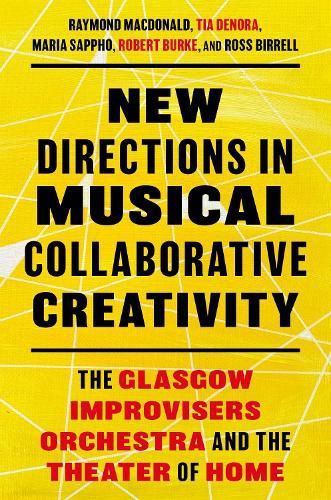Readings Newsletter
Become a Readings Member to make your shopping experience even easier.
Sign in or sign up for free!
You’re not far away from qualifying for FREE standard shipping within Australia
You’ve qualified for FREE standard shipping within Australia
The cart is loading…






During the COVID-19 pandemic, creative communities were faced with unprecedented challenges and forced to embark upon a re-evaluation of traditional approaches to artistic collaboration. In the wake of these discussions and experiments, New Directions in Musical Collaborative Creativity asks how new technology can be used to enhance creativity and how this creativity increases our knowledge in relation to musical interactions in group contexts. Focusing on a case study of a leading musical improvisation group--the Glasgow Improvisers Orchestra, and their online music sessions established during the COVID-19 lockdowns of March 2020--the book's five authors probe the transformative impact of online and hybrid improvisation and explore the crucial role of interactive (visual and sound) technology in the emergence of new identities and hybrid working practices.Virtual improvising, though a relatively new type of creative activity, has significant implications for how researchers can better understand improvisation generally as well as musical interactions in non-virtual environments. The book's topics range from an overview of digital music frameworks to an investigation of how improvisations begin and end, the unique context of the online sessions, the integration of audio and visual stimuli to produce audio-visual compositions, and new types of creative activities. The authors explore how improvisation--and online improvising in particular--can engender a fresh sense of community while presenting innovative opportunities for experimentation, communication, community involvement, educational enrichment, the cultivation of new virtuosities, and the promotion of health and well-being. Furthermore, they delve into the ramifications of these insights for education and health, emphasising the importance of new technologies and their potential to produce significant creative breakthroughs.Ultimately, the book points us toward novel manifestations of technologically-mediated and community-centred creative engagement, delineating avenues for future advancement and scholarly investigation. Bringing together a multidisciplinary and cross-generational author team with a wealth of complementary academic and artistic experience, this book responds to the significant growth in interest in improvisation as a musical and artistic practice and situates this research within the study of collaborative creativity in the contemporary "hybrid" context. A companion website features a series of films that document sessions of the Glasgow Improvisers Orchestra, showing the innovative collaborative artistic practices as they emerged.
$9.00 standard shipping within Australia
FREE standard shipping within Australia for orders over $100.00
Express & International shipping calculated at checkout
During the COVID-19 pandemic, creative communities were faced with unprecedented challenges and forced to embark upon a re-evaluation of traditional approaches to artistic collaboration. In the wake of these discussions and experiments, New Directions in Musical Collaborative Creativity asks how new technology can be used to enhance creativity and how this creativity increases our knowledge in relation to musical interactions in group contexts. Focusing on a case study of a leading musical improvisation group--the Glasgow Improvisers Orchestra, and their online music sessions established during the COVID-19 lockdowns of March 2020--the book's five authors probe the transformative impact of online and hybrid improvisation and explore the crucial role of interactive (visual and sound) technology in the emergence of new identities and hybrid working practices.Virtual improvising, though a relatively new type of creative activity, has significant implications for how researchers can better understand improvisation generally as well as musical interactions in non-virtual environments. The book's topics range from an overview of digital music frameworks to an investigation of how improvisations begin and end, the unique context of the online sessions, the integration of audio and visual stimuli to produce audio-visual compositions, and new types of creative activities. The authors explore how improvisation--and online improvising in particular--can engender a fresh sense of community while presenting innovative opportunities for experimentation, communication, community involvement, educational enrichment, the cultivation of new virtuosities, and the promotion of health and well-being. Furthermore, they delve into the ramifications of these insights for education and health, emphasising the importance of new technologies and their potential to produce significant creative breakthroughs.Ultimately, the book points us toward novel manifestations of technologically-mediated and community-centred creative engagement, delineating avenues for future advancement and scholarly investigation. Bringing together a multidisciplinary and cross-generational author team with a wealth of complementary academic and artistic experience, this book responds to the significant growth in interest in improvisation as a musical and artistic practice and situates this research within the study of collaborative creativity in the contemporary "hybrid" context. A companion website features a series of films that document sessions of the Glasgow Improvisers Orchestra, showing the innovative collaborative artistic practices as they emerged.